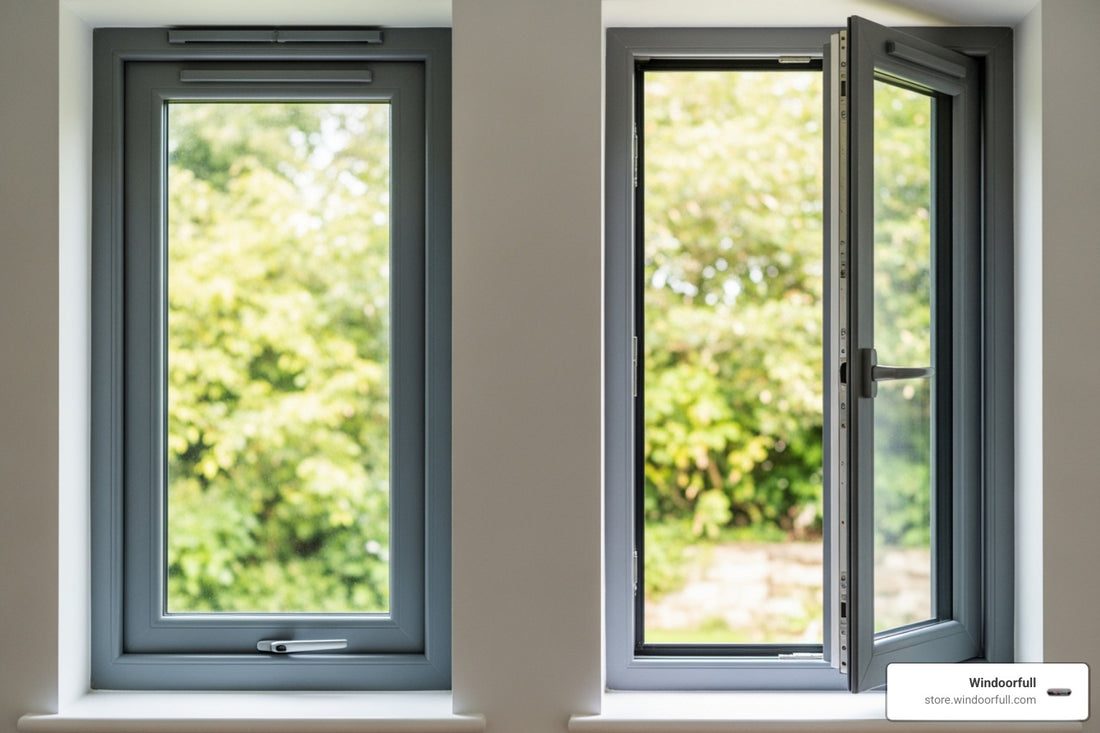
Which Window Wins? Tilt and Turn vs. Casement Explained
Share
Why Choosing Between Window Types Matters for Your Home
Tilt and turn windows vs casement represents one of the most important decisions you'll make when upgrading your home's windows. These two popular window styles offer completely different approaches to ventilation, security, and functionality.
Here's the quick comparison:
Tilt and Turn Windows:
- Operation: Dual-action - tilt inward from top OR swing fully inward like a door
- Best for: Modern homes, families with children, upper floors, balconies
- Key benefits: Superior security, easy cleaning from inside, versatile ventilation
- Cost: $400-$1,300 per window
Casement Windows:
- Operation: Single-action - swing outward on side hinges using crank mechanism
- Best for: Traditional homes, maximum airflow, unobstructed views
- Key benefits: Excellent ventilation, simple operation, weather-tight seal in wind
- Cost: $300-$1,000 per window
The main difference? Tilt and turn windows open inward with two different positions, while casement windows always swing outward. This fundamental difference affects everything from security and cleaning to where you can install them.
As someone who's spent years working with European-style window systems at Windoorfull Imports Inc., I've helped countless homeowners steer the tilt and turn windows vs casement decision. My experience with German-engineered tilt-and-turn systems has shown me how this dual functionality can transform how you interact with your windows daily.
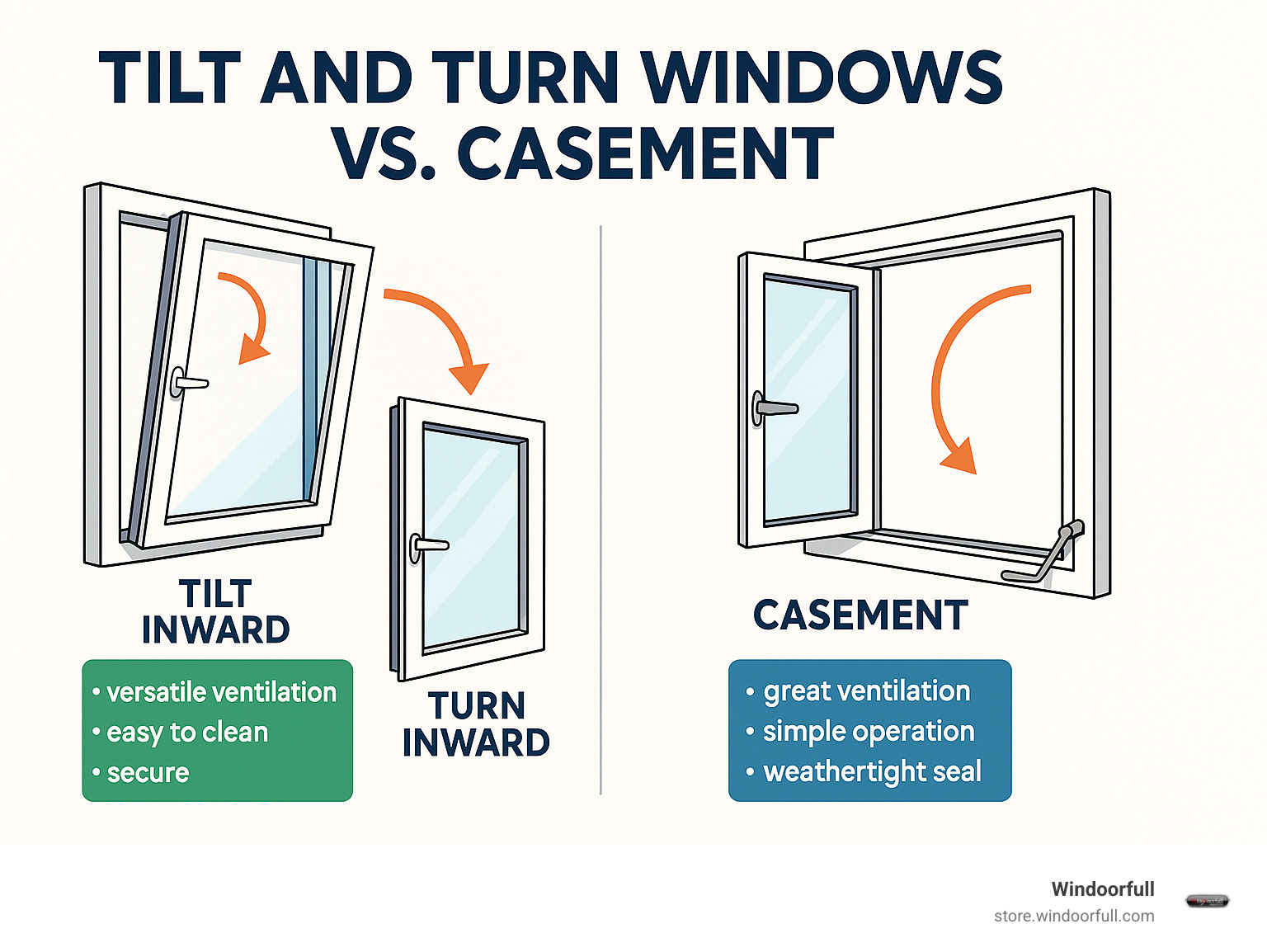
What's the Difference? Operation and Mechanism Explained
The core difference between tilt and turn windows vs casement lies in how they open. Tilt and turn windows open inward with two distinct functions, while casement windows swing outward in a single motion. This fundamental distinction affects everything from ventilation and security to daily use.
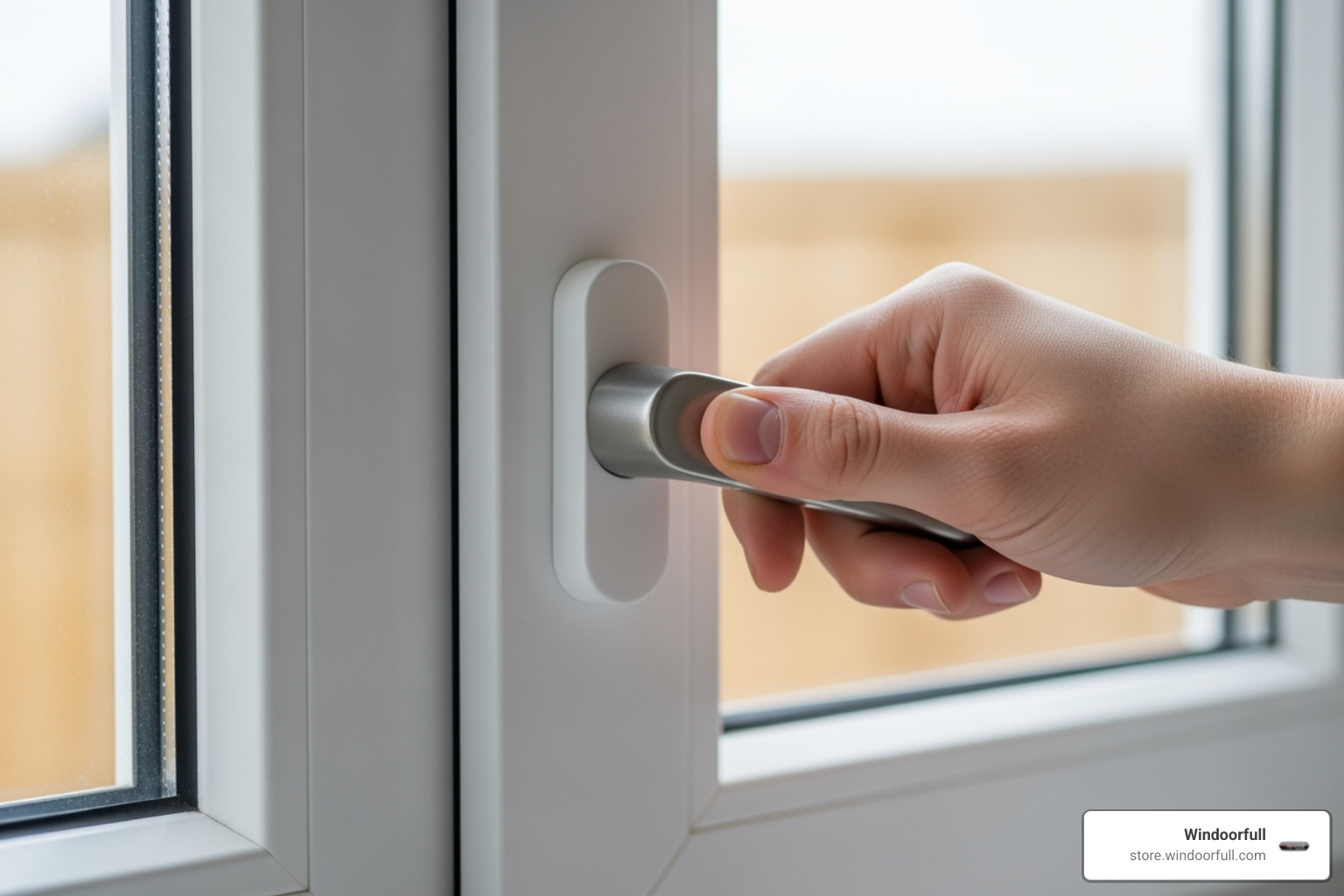
With a tilt and turn window, a single handle controls both actions. Turn it one way, and the top of the window tilts inward about 6 inches for secure, gentle ventilation. Turn it another way, and the entire window swings open like a door.
Casement windows are simpler: they are hinged on one side and crank outward. There are no multiple positions, just a straightforward outward swing.
Tilt and Turn Windows: The Dual-Function Innovator
Rooted in European design principles, particularly German engineering, these windows are incredibly practical.
The tilt function creates a secure opening at the top, perfect for continuous ventilation without compromising safety. It's safe for children and pets, deters intruders, and even works during light rain as the tilted glass acts as an awning.
The turn function allows the entire window to swing inward like a door. This is a game-changer for cleaning, as you can easily reach both sides of the glass from inside your home, eliminating the need for ladders on upper-story windows.
A key feature is the multi-point locking system. Tilt and turn windows lock at multiple spots around the frame—sometimes up to 12 points—creating a highly secure seal that makes break-ins much more difficult. The inward swing also protects the hinges from weather and tampering. At Windoorfull, we've seen this European engineering create windows that handle over 40,000 opening cycles while maintaining their tight seal.
Casement Windows: The Classic Outward-Opening Choice
Casement windows are the traditional choice for many American homes. They are side-hinged (or top-hinged for awning styles) and swing outward using a crank or lever.
Their outward swing provides completely unobstructed views when fully open. They are also excellent at catching breezes and directing airflow into your home, making them popular for kitchens and other areas where maximum ventilation is desired. The simple crank operation works well even in hard-to-reach spots, like over a kitchen sink.
When closed, casement windows create an excellent weather seal. Wind pushes the sash tighter against the frame, improving energy efficiency in windy conditions.
The main trade-off is their need for exterior clearance. They can obstruct walkways or interfere with landscaping. Their exposed hinges also face the elements, which can be a long-term maintenance consideration.
The Pros and Cons: A Detailed Breakdown
When weighing tilt and turn windows vs casement, it's about matching the window's features to your daily life. Each style has distinct advantages and challenges.
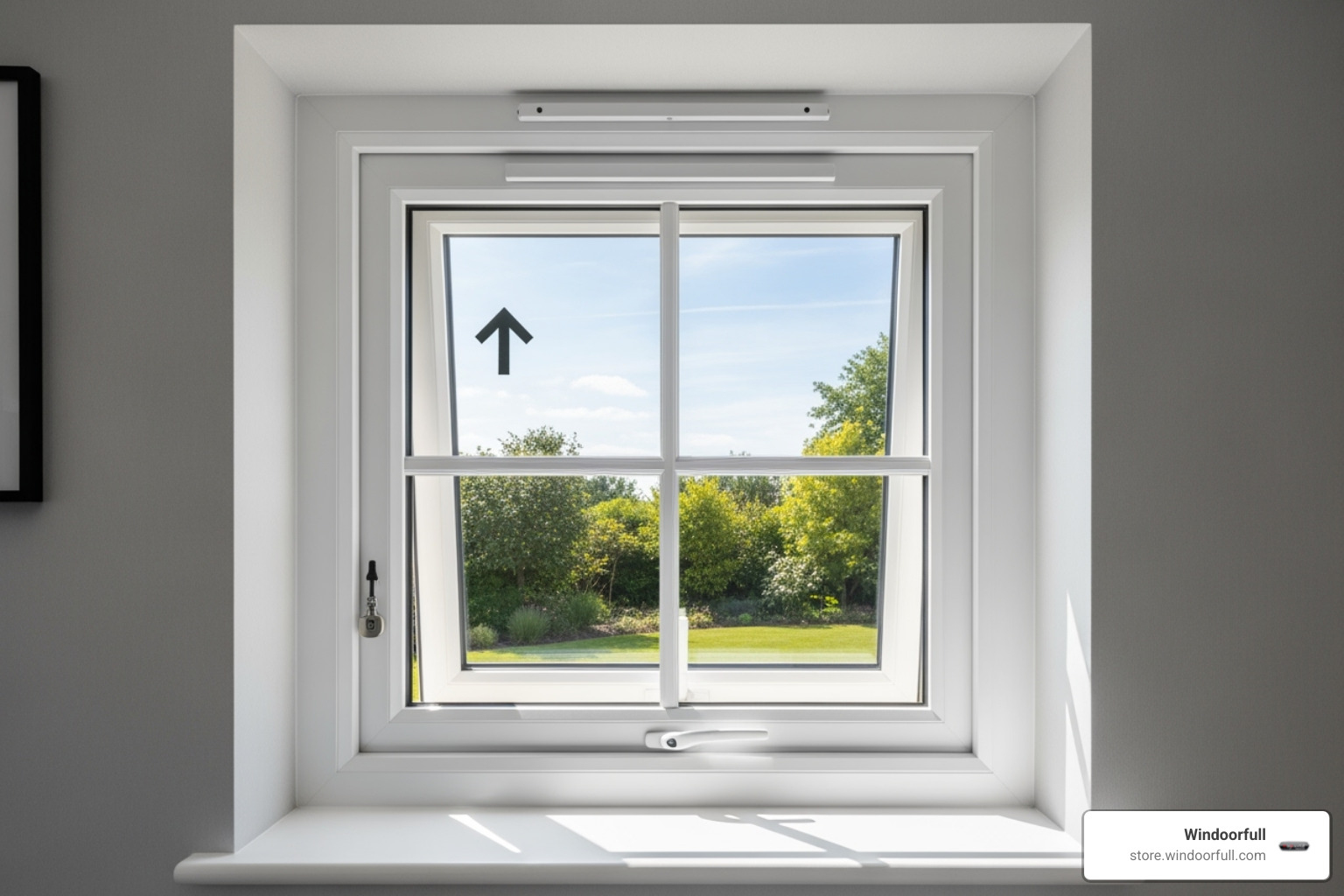
Advantages and Disadvantages of Tilt and Turn Windows
The primary benefit of tilt and turn windows is their versatility.
Pros:
- Superior Security: Multi-point locking systems (4-12 points) create a secure seal. The tilt function allows for ventilation without compromising safety, giving parents peace of mind.
- Easy Cleaning: The entire window swings inward, allowing you to clean both sides from inside. This is a major advantage for upper-story windows, saving money on professional cleaning services.
- Modern Aesthetics: Clean lines and sleek handles complement contemporary homes.
- Space-Saving: Because they open inward, they are ideal for balconies and areas with limited exterior space.
Cons:
- Interior Clearance: You must plan for furniture placement, as the inward swing requires clear space.
- Higher Initial Cost: The cost is typically higher ($400-$1,300 per window), but many find the long-term benefits in security and convenience justify the investment.
- Complex Mechanism: The sophisticated design requires professional installation to ensure proper function.
Advantages and Disadvantages of Casement Windows
Casement windows are a classic choice that excels in specific applications.
Pros:
- Maximum Airflow: When fully open, they catch side breezes and direct them into the home, providing excellent ventilation.
- Uninterrupted Views: With no center post, they offer a clear, panoramic view.
- Excellent Weather Sealing: Wind pushes the sash tighter against the frame, creating a strong seal that improves energy efficiency.
- Simple Operation: The crank mechanism is easy to use, even in hard-to-reach spots like over a kitchen sink.
- Traditional Style: They are a perfect fit for traditional and historic homes.
Cons:
- Exterior Obstructions: The outward swing can interfere with walkways, decks, or landscaping.
- Security Concerns: Exposed hinges on older models can be a vulnerability.
- Difficult Cleaning: Reaching the exterior of upper-story casements is challenging and may require professional help.
- Screening Challenges: Screens must be designed to accommodate the outward swing, which can be complicated.
Tilt and Turn Windows vs Casement: A Feature-by-Feature Comparison
Breaking down the key features of tilt and turn windows vs casement makes the choice much clearer.
| Feature | Tilt and Turn Windows | Casement Windows |
|---|---|---|
| Operation | Dual (tilt inward from top, swing fully inward) | Single (swing fully outward) |
| Ventilation | Versatile (secure tilt, full swing, micro-ventilation) | Excellent (full outward swing catches breezes) |
| Security | High (multi-point locks, inward opening protects hinges) | Good (when closed, wind pressure aids seal; hinges can be vulnerable) |
| Cleaning | Very Easy (both sides from inside) | Moderate (exterior often requires outside access) |
| Aesthetics | Modern, sleek, minimalist (single handle) | Classic, traditional, timeless |
| Space Req. | Inward clearance needed | Outward clearance needed |
| Child Safety | High (tilt mode is secure) | Moderate (full opening can be a hazard) |
| Cost (Typical) | $400 - $1,300 per window | $300 - $1,000 per window |
| Views | Unobstructed when fully open | Unobstructed when open or closed |
| Screens | Easy to fit (exterior mounting) | Can be challenging (interferes with outward swing) |
Energy Efficiency and Noise Insulation
Both window types can be highly energy-efficient, but they achieve it differently.
Casement windows create a strong seal when closed, as wind pressure forces the sash tighter against the frame. This makes them very effective at preventing air leakage in windy climates.
European-style tilt and turn windows are engineered to meet strict European energy standards. Their multi-point locking system creates continuous compression around the entire perimeter, much like a submarine hatch. This superior seal minimizes heat loss. Our windows feature double or triple glazing, argon gas fills, and warm edge spacers to achieve low U-values. Different window types have varying performance against air leakage; the Efficient Windows Collaborative's research on window types shows that tilt and turn windows are among the best performers.
For noise insulation, the robust frame and comprehensive sealing of tilt and turn windows, combined with high-performance glazing, create an impressive sound barrier, often giving them an edge over casements in creating a peaceful indoor environment.
Security and Durability
The engineering differences between the two styles are most apparent in security and durability.
Tilt and turn windows feature 4 to 12 locking points around the frame, all controlled by a single handle. This system securely fastens the window at multiple points. The inward-opening design also protects the hinges from outside tampering.
Casement windows typically rely on one or two locking points. While modern designs have improved, older units can be vulnerable.
In terms of durability, our European-style tilt and turn windows feature steel core reinforcement within their uPVC frames, making them significantly stronger than many standard vinyl casement windows. Hardware tests show tilt and turn hinges operating perfectly after 40,000 cycles, outlasting many casement mechanisms.
Installation and Cost Comparison
Professional installation is crucial for both types, but the sophisticated mechanism of tilt and turn windows requires more precision.
The cost breakdown is as follows:
- Casement windows: $300 to $1,000 per window installed.
- Tilt and turn windows: $400 to $1,300 per window installed.
Prices vary based on frame material, glazing options, hardware, size, and installation complexity. While tilt and turn windows have a higher upfront cost, their long-term value is significant. The savings from improved energy efficiency, reduced maintenance, and superior durability often make them a sound financial investment over the window's lifespan.
Making the Right Choice: Best Applications for Each Window
The decision between tilt and turn windows vs casement depends on your property's style, your lifestyle, and your priorities for ventilation, security, and maintenance.
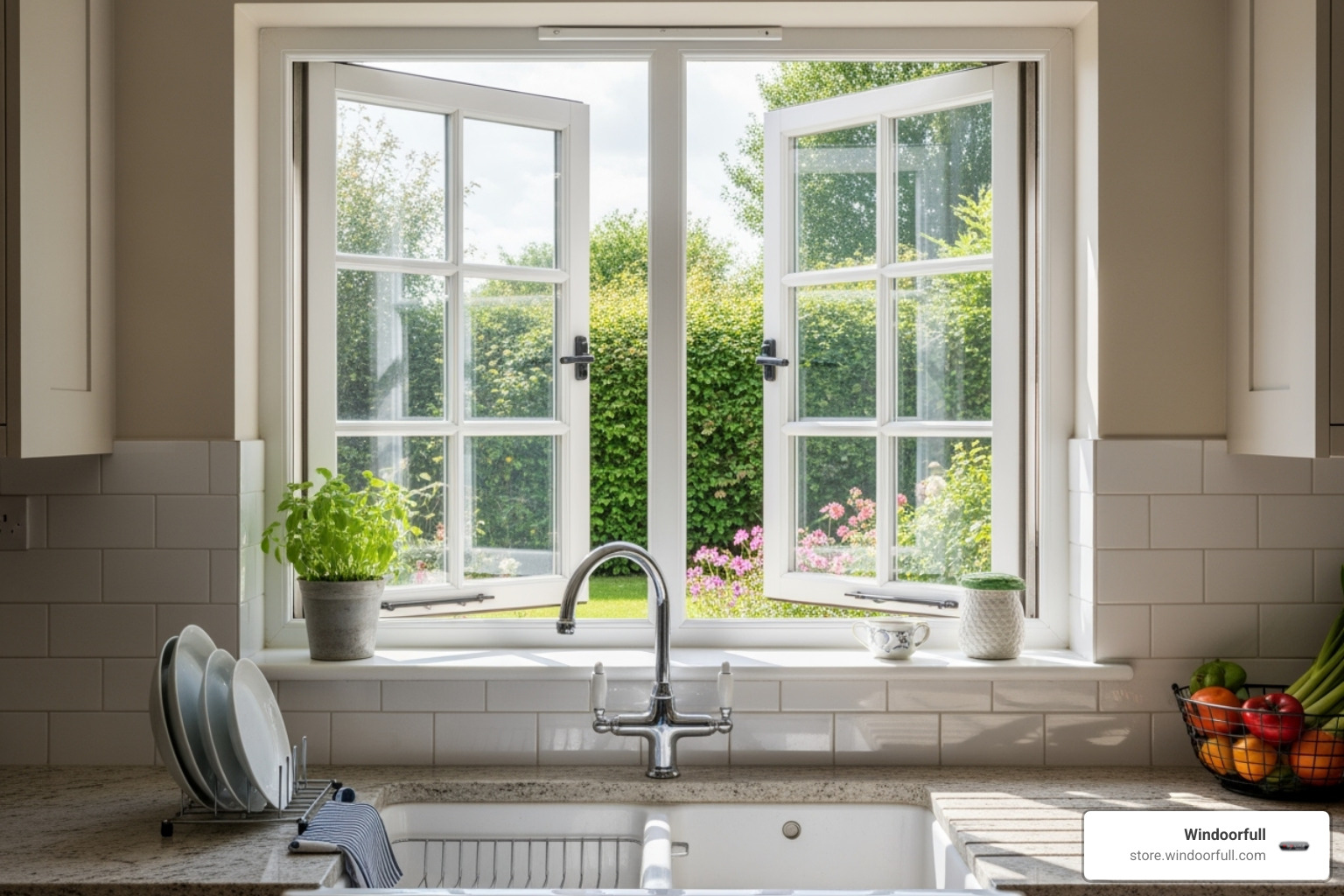
When to Choose Tilt and Turn Windows
Tilt and turn windows excel in situations where their dual functionality provides a clear advantage.
- Modern Homes: Their sleek, minimalist appearance is a perfect match for contemporary architecture.
- Upper-Story Rooms: The inward-swinging turn function makes cleaning second-floor windows safe and easy, eliminating the need for ladders or professional services.
- Families with Children or Pets: The secure tilt function allows for fresh air without the risk of falls or escapes, providing valuable peace of mind.
- Homes with Balconies or Limited Exterior Space: The inward opening design doesn't obstruct balconies, patios, or narrow walkways.
- When Security is a Priority: The multi-point locking system and protected hinges offer superior security.
- For Maximum Energy Efficiency: Our European-engineered uPVC windows are designed to meet strict energy standards, leading to lower utility bills.
The Smart Choice for Modern Homes: Why Tilt and Turn Windows Belong in Your USA Home.
When to Choose Casement Windows
Casement windows remain an excellent choice for specific needs and architectural styles.
- Traditional or Historic Homes: Their timeless look maintains the authentic character of colonial, craftsman, or Victorian homes.
- Conservation Areas: They are often required by homeowners associations or historic preservation guidelines.
- For Maximum Ventilation: In kitchens or bathrooms, their ability to catch and direct breezes is best.
- Hard-to-Reach Areas: The simple crank mechanism is ideal for windows located over kitchen sinks or other obstructions.
- When Exterior Space is Plentiful: If the outward swing doesn't create an obstruction, casements are a great option.
Frequently Asked Questions about Tilt and Turn vs. Casement Windows
After helping countless homeowners steer the tilt and turn windows vs casement decision, I've noticed the same questions come up again and again. Let me address the most common concerns with straight answers based on real-world experience.
Are tilt and turn windows more secure than casement windows?
Yes, they generally are – and the difference is quite significant. Think of it this way: would you feel safer with a door that has one lock or twelve? That's essentially what we're comparing here.
Tilt and turn windows come equipped with multi-point locking systems that engage automatically when you close the handle. These systems typically have 4 to 12 locking points around the entire frame perimeter, creating a fortress-like seal. Compare this to most casement windows, which rely on just one or two locking points.
But the security advantage goes beyond just the number of locks. The inward opening design protects the hinges from tampering since they're located inside your home rather than exposed to the exterior. This makes it nearly impossible for someone to remove hinge pins or force the hinges from outside.
Even when you want ventilation, tilt and turn windows let you ventilate securely in the tilt position. The narrow opening at the top provides fresh air while being too small for anyone to climb through. It's like having your cake and eating it too – fresh air without compromising security.
Which window is easier to clean?
Tilt and turn windows win this one hands down, especially if you have upper-story windows. I can't tell you how many customers have told me this feature alone justified their choice.
Here's why cleaning is so much easier: the entire sash swings fully inward, bringing both sides of the glass right to you. No more precariously balancing on ladders, hiring window cleaners, or doing gymnastics to reach the outside surface. You simply turn the handle, swing the window open like a door, and clean both sides safely from inside your home.
This is a major benefit for upper-floor windows where cleaning the exterior would normally require professional help or dangerous DIY ladder work. With casement windows, you're stuck cleaning only the interior surface easily – the exterior requires outside access, which can be challenging or even impossible for higher floors.
For ground-floor windows, casement windows are certainly manageable to clean, but even then, you'll appreciate the convenience of cleaning everything from inside, especially during bad weather.
Can you put screens on tilt and turn windows?
Yes, absolutely – and ironically, it's often easier than with casement windows. This surprises many people because they assume inward-opening windows would complicate screening.
Here's the clever part: because tilt and turn windows open inward, screens are fitted to the exterior of the frame. This means the screen doesn't interfere with the window's operation at all. Whether you're tilting for ventilation or swinging the window fully open, the screen stays put on the outside.
With casement windows that swing outward, screens become more complicated. The screen has to somehow accommodate the outward swing, which often means more complex mounting systems or screens that need to be removed when you want to open the window fully.
Our European-style tilt and turn windows are designed with screening in mind, making it a straightforward addition that maintains both functionality and aesthetics. It's one of those details that shows how thoughtfully these windows are engineered – they've considered not just the primary function, but all the practical aspects of daily use.
Conclusion: The Best Window for Your American Home
After exploring every angle of tilt and turn windows vs casement, the truth is simple: there's no universal "winner" – only the perfect match for your specific home and lifestyle.
If you're drawn to timeless elegance and maximum airflow, casement windows deliver beautifully. Their classic outward swing, unobstructed views, and ability to catch every breeze make them a natural fit for traditional homes and rooms where ventilation is king. They've earned their place as an American favorite through decades of reliable performance.
But here's what I've witnessed after years of helping homeowners upgrade their windows: tilt and turn windows represent a genuine leap forward in window technology. Their dual functionality isn't just clever engineering – it's a daily game-changer.
Think about it: secure ventilation that keeps children and pets safe, effortless cleaning from inside your home (no more ladder trips!), and security that actually lets you sleep better at night. These aren't just features – they're solutions to real problems every homeowner faces.
At Windoorfull, we've made it our mission to bring authentic European engineering directly to American homes without the European price tag. Our uPVC tilt and turn windows combine superior energy efficiency with that versatile functionality that makes daily life just a little bit easier. When you experience the smooth operation of a well-made tilt and turn window – that satisfying click of the multi-point locks engaging, the gentle tilt for morning ventilation, the full swing for spring cleaning – you'll understand why European homeowners have acceptd this technology for decades.
The best window for your home is the one that fits your lifestyle, complements your architecture, and makes you smile every time you use it. Whether that's the classic charm of casement or the innovative versatility of tilt and turn, the choice is yours.
Ready to experience the difference? Explore our collection of modern, high-performance tilt and turn windows and find why more American homeowners are making the switch to European-style functionality.
